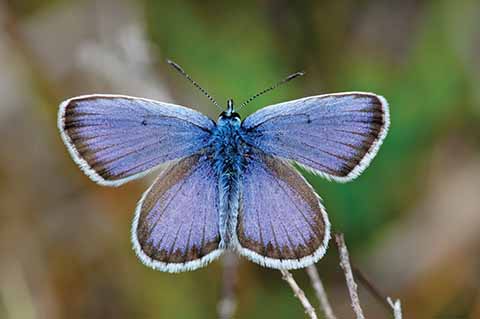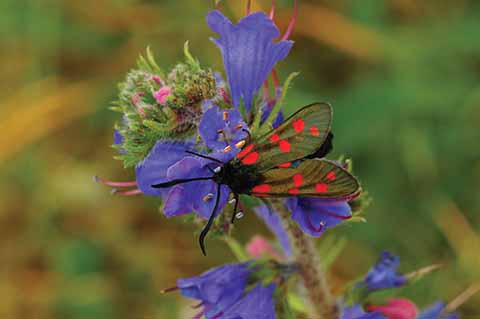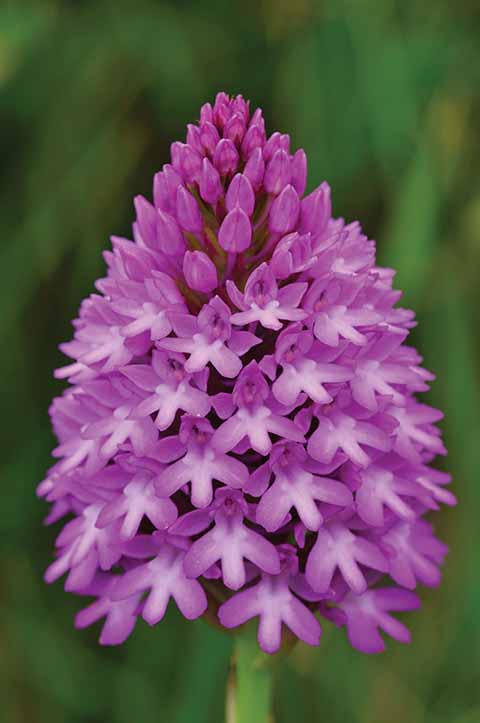Cheyne Weares wildlife
Colin Varndell descends into Duncecroft Quarry to find an astonishing abundance of flora and fauna
Published in October ’19
If you visit the car park and viewpoint on the road from Southwell to Portland Bill, the view to the west takes in the turbulent waters of the Portland Race. Here, strong currents meet from different directions and are further confused by the shallow depth at this point due to the submerged ledge. Before the lighthouses were built, this treacherous cauldron of choppy, wild water caused many shipwrecks. The view to the east takes in much of the Purbeck coastline. There is a constant stream of cars arriving at the viewpoint, the occupants here to enjoy the view and soak up the atmosphere of this special place on summer afternoons.
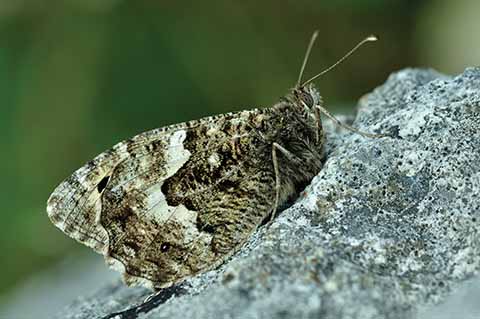
The mottled colours on the underside of a grayling’s wings enable it to ‘vanish’ as it settles on the ground
But many of those who visit are unaware of the magical place immediately below. The descent into Duncecroft Quarry is dangerous, involving in places sliding down sheer steep paths of loose stones. This is not for the faint-hearted or for anyone unfit, because once down at the bottom, you are faced with the prospect of climbing back up without the help of gravity.
This wilderness area is a deep open mouth of space, littered with great heaps of stone. It is enclosed on three sides by rock faces, the fourth by the sheer cliff below and the open sea. The difficult descent deters most humans, so this is a sanctuary where wildlife goes about its business undisturbed for much of the time, although the perpendicular cliff face below is popular with rock-climbing groups.
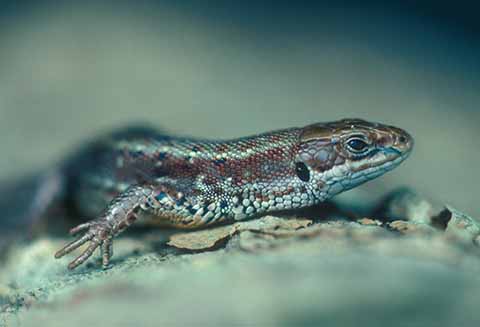
Common lizards bask in order to raise their body temperature for activity. They feed mainly on small insects and spiders.
Some interesting wild plants thrive here like common broomrape, a root parasite of clovers and hawksbeard flowers. Stunted bee orchids occur in the thin, short turf above the limestone. Pyramidal orchids are abundant in high summer as well as Portland’s very own species of spurge, aptly named Portland spurge. Although it can be found elsewhere along the coast, it was here on the island that it was first recorded.
Amongst the rocks and on bare ground, the diminutive eyebright shows off its tiny blooms in summer. This cheerful little flower is intriguingly referred to locally as ‘Gentleman Tailor’. Other species of particular note found in this quarry are horseshoe vetch, marjoram, wood sage, birdsfoot trefoil, rockrose and the silky-grey sprawling kidney vetch with its deep yellow, orange or fiery red flowers.
Two of the most dramatic displays of colour in summer are provided by red valerian and vipers bugloss. Red valerian is most abundant here, spreading itself in great tides of red and white blooms. Viper’s bugloss is a tall biennial, bearing its blooms on spikes and forming expansive drifts of deep blue. The vivid yellow of eastern rocket contrasts with the blue of viper’s bugloss, while the curious spires of lime-green weld reach up through blue haze.
Buddleia bushes are well-established and act as magnets to butterflies throughout July and August, attracting such species as painted lady, small tortoiseshell and humming bird hawkmoth. Resident butterflies at this site include the silver-studded blue. This butterfly is very like the common blue but slightly smaller. It can be distinguished by the arc of metallic studs on the underside of the hind wing. The food plants of the caterpillars of this species on Portland are mainly birds-foot trefoil, horseshoe vetch and occasionally other legumes.
The grayling is a large, fast-flying butterfly, easy to see in flight, but as it settles on bare ground, its mottled wings provide the perfect disguise to make it almost invisible.
The common lizard as its name suggests, is a widespread species, occurring in a range of dry habitats. In this old quarry, common lizards typically bask out in the open on rocks close to vegetation into which they can retreat if disturbed. On the other hand, the wall lizard is not common, but it is a busy reptile, often seen crawling over vertical rock faces. Females lay several clutches of up to eight eggs, which hatch in late summer. These reptiles are thought to have come to Portland on boats collecting stone during the last century. They have been breeding here and also in Tout Quarry for decades. Although the wall lizard started its Dorset colony here, it is now spreading across Dorset and has been recorded as far away as Bridport, sunning itself on garden walls. Late afternoon in high summer is an ideal time to see these animals as they come out into the open to soak up the ebbing warmth of the sun.
Two falcons regularly nest here, the peregrine and the kestrel. Peregrines hunt along the coast for stock doves and pigeons, while kestrels hover motionless, watching for the movement of voles in rough ground on the island. Kestrels and stock doves nest in deep crevices in the rock faces of the defunct quarry.
Rock pipits bound around the rocks, picking flies and other invertebrates off the abundant plant life. Linnets are also residents here, the summer air full of their pretty songs and calls.
Portland is acknowledged to be of national importance for wildlife conservation, and several of its redundant quarries are now designated as Sites of Special Scientific Interest. These days we are constantly being made aware of how human development and commercial activities threaten our natural heritage, yet the many decades of quarrying on Portland have created and enhanced new and exciting habitats for wildlife. Cheyne Weares is a fine example of such a wild environment, supporting a rich variety of flora and fauna, some of which cannot be observed anywhere else on mainland Britain.
